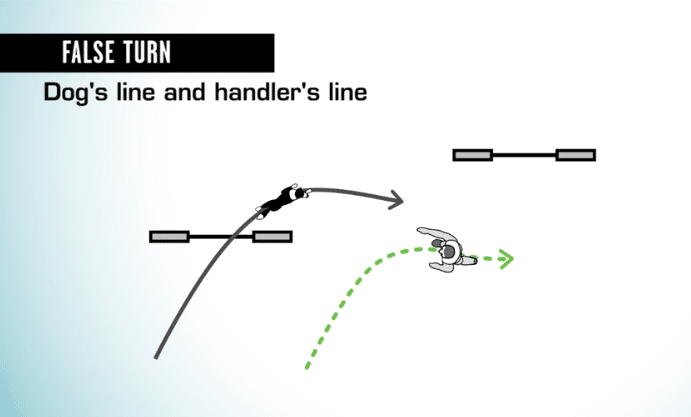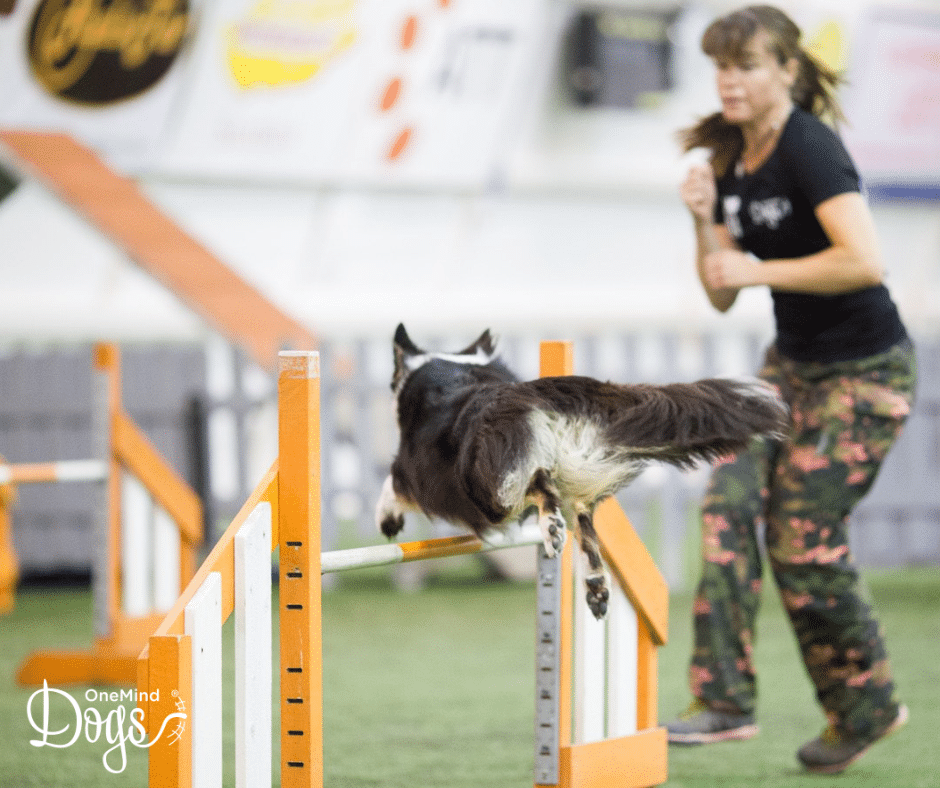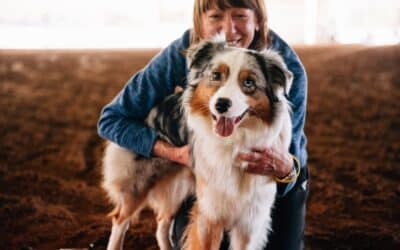Dog agility handlers aim for seamless communication between handler and dog on the course. Using handling techniques based on body language is a simple solution to achieve flow in a way that comes naturally to the dog. One such technique that embodies this harmony is the False Turn. This handling maneuver allows you to change your dog’s line while staying on the same handling side, enabling constant movement and fluid performance. Let’s dive into the intricacies of the False Turn and how you can perfect it with our online mini-course.

What is a False Turn?
A False Turn is a strategic agility handling technique used to redirect your dog’s line without switching sides. This handling tool is especially useful in tight, complex courses where accuracy and early information to the dog is crucial. Handlers can ensure a smoother run and better control over their dog’s movements by mastering the False Turn.
Why Use a False Turn?
The False Turn is advantageous for several reasons:
- Continuous Movement: It allows handlers to keep moving, avoiding any pauses that could disrupt the dog’s flow.
- Precision: It provides precise control over the dog’s line, ensuring they follow the intended path and get plenty of information about the upcoming turn.
- Efficiency: It helps in navigating tight turns and complex sequences more efficiently. Allowing the dog to move comfortably and safely through tight sequence
The Importance of Learning Different Handling Techniques
In dog agility, having a well rounded toolbox of different handling techniques is key. Learning different handling techniques, like the False Turn, equips you with a variety of tools to tackle different courses. Each agility course presents unique challenges, and having a diverse set of handling techniques allows you to adapt and choose the best approach for any given situation.
Think of handling techniques as tools in your toolbox. The more tools you have, the better equipped you are to handle any obstacle or course layout. By mastering multiple techniques, you can optimize your dog’s performance, making each run smoother and more efficient.
Learn the False Turn with Our Mini-Course
Our mini-course is designed to help you master the False Turn, whether you’re a beginner or looking to refine your technique. The course covers the 7 essential elements, foundation teaching steps and applying the technique in a sequence. The videos provide detailed explanations and demonstrations of both the dog’s and handler’s lines.
The 7 Elements of a False Turn
Each OneMind Dogs handling technique is made up of 7 elements that are important to your dog. When you understand how your dog perceives these elements, handling becomes much more instinctive. Learn more in this free webinar.
- Movement: Move in the direction of the dog’s intended line after the obstacle. Your movement cues your dog to follow the correct path.
- Position: Position yourself either next to or in front of your dog, depending on the course layout and your strategy.
- Eyes: Ensure your dog is committed to the obstacle before shifting your gaze to the intended line. This helps maintain focus and direction.
- Chest: Keep your chest pointing towards the take-off point until the dog commits to the obstacle. During the False Turn, your chest should align with the dog’s intended line, then turn towards the next obstacle once the dog is on track.
- Legs: Your feet should turn towards the dog initially. Once the dog is on the correct line, point your feet forward towards the next obstacle to guide them effectively.
- Arms: Use the arm on the dog’s side to commit them to the obstacle. After commitment, briefly switch the guiding arm, then revert to the dog-side arm once the dog is on the correct line.
- Voice: Use verbal cues to establish a connection when starting the False Turn. This helps reinforce the command and keeps your dog attentive.
Dog’s Line during the False Turn
Understanding your dog’s line is crucial. The False Turn relies on precise timing and positioning to ensure your dog follows the intended path without confusion. Early and clear cues are essential to make this technique effective, allowing your dog to collect on the obstacle before the turn so that they can land safely and have an optimal line tot he next obstacle.
Cue Early: The earlier you cue the False Turn, the smoother and more responsive your dog will be. If your dog seems unresponsive, try initiating the cue sooner to give them ample time to adjust.
The Benefits of a Well-Equipped Toolbox
Having a variety of handling techniques at your disposal is like having a well-equipped toolbox. Each technique offers a different way to communicate with your dog and navigate the course. By learning and mastering techniques like the False Turn, you will have more options available to you, to tackle all kinds of courses! This adaptability is invaluable during competitions, where course designs can vary greatly and present unexpected challenges. If you have trouble choosing the right techniques from your toolbox, have a look at this free webinar.
Moreover, a diverse set of handling skills enhances your ability to respond to your dog’s needs in real-time. It fosters a deeper understanding and connection between you and your dog, as you both learn to navigate courses with increased confidence and coordination.
Conclusion
Mastering the False Turn can significantly enhance your agility performance, allowing for smoother runs and better control. By focusing on the 7 elements and practicing regularly, you can perfect this technique and see remarkable improvements in your agility skills. Start your journey today with our online mini-course and experience the joy of seamless agility training.



